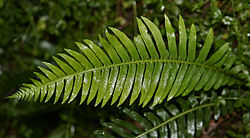Embryophyta
| Tumbuhan darat | |
|---|---|

| |
| Daun paku | |
| Klasifikasi ilmiah | |
| Kerajaan: | |
| (tanpa takson): | |
| Upakerajaan: | |
| Divisi | |
Pengelompokan tradisional: | |
| Sinonim | |
Embryophyta adalah subkingdom paling akrab dari tanaman hijau yang membentuk vegetasi di bumi. Embryophyta yang masih hidup termasuk lumut tanduk, lumut hati, lumut daun, pakis, lycophyta, gymnospermae dan tumbuhan berbunga, tetapi tidak mencakup alga hijau. Embryophyta secara informal disebut tumbuhan darat karena mereka tinggal terutama di habitat darat, sedangkan ganggang hijau hidup terutama di air. Semuanya eukariota multiseluler kompleks dengan organ reproduksi khusus. Namanya berasal dari karakteristik inovatif mereka memelihara embrio sporofit muda selama tahap awal pengembangan multiseluler dalam jaringan gametofit induk. Dengan beberapa pengecualian, embryophyta memperoleh energi mereka dengan fotosintesis, yaitu dengan menggunakan energi sinar matahari untuk mensintesis makanan mereka dari karbon dioksida dan air.
Referensi
- ^ Gray, J.; Chaloner, W.G. & Westoll, T.S. (1985), "The Microfossil Record of Early Land Plants: Advances in Understanding of Early Terrestrialization, 1970-1984 [and Discussion]", Philosophical Transactions of the Royal Society B: Biological Sciences, 309 (1138): 167, Bibcode:1985RSPTB.309..167G, doi:10.1098/rstb.1985.0077
- ^ Rubinstein, C.V.; Gerrienne, P.; De La Puente, G.S.; Astini, R.A. & Steemans, P. (2010), "Early Middle Ordovician evidence for land plants in Argentina (eastern Gondwana)", New Phytologist, 188 (2): 365–9, doi:10.1111/j.1469-8137.2010.03433.x, PMID 20731783
- ^ Engler, A. 1892. Syllabus der Vorlesungen über specielle und medicinisch-pharmaceutische Botanik: Eine Uebersicht über das ganze Pflanzensystem mit Berücksichtigung der Medicinal- und Nutzpflanzen. Berlin: Gebr. Borntraeger.
- ^ Pirani, J. R.; Prado, J. (2012). "Embryopsida, a new name for the class of land plants" (PDF). Taxon. 61 (5): 1096–1098.
- ^ Barkley, Fred A. Keys to the phyla of organisms. Missoula, Montana. 1939.
- ^ Rothmaler, Werner. Über das natürliche System der Organismen. Biologisches Zentralblatt. 67: 242-250. 1948.
- ^ Barkley, Fred A. "Un esbozo de clasificación de los organismos." Revista de la Facultad Nacional de Agronomia, Universidad de Antioquia, Medellín. 10: 83-103, [1].
- ^ Takhtajan, A. (1964). The taxa of the higher plants above the rank of order. Taxon 13(5): 160-164, [2].
- ^ Cronquist, A., Takhtajan, A. & Zimmermann, W. (1966). On the Higher Taxa of Embryobionta. Taxon, Vol. 15, No. 4 (Apr., 1966), pp. 129-134, [3].
- ^ Whittaker, R. H. (1969). "New concepts of kingdoms or organisms" (PDF). Science. 163 (3863): 150–160.
- ^ Margulis, L (1971). "Whittaker's five kingdoms of organisms: minor revisions suggested by considerations of the origin of mitosis". Evolution. 25: 242–245.
Bibliografi
- Raven, P.H.; Evert, R.F. & Eichhorn, S.E. (2005), Biology of Plants (edisi ke-7th), New York: W.H. Freeman, ISBN 978-0-7167-1007-3
- Stewart, W.N. & Rothwell, G.W. (1993), Paleobotany and the Evolution of Plants (edisi ke-2nd), Cambridge: Cambridge University Press, ISBN 978-0-521-38294-6
- Taylor, T.N.; Taylor, E.L. & Krings, M. (2009), Paleobotany, The Biology and Evolution of Fossil Plants (edisi ke-2nd), Amsterdam; Boston: Academic Press, ISBN 978-0-12-373972-8